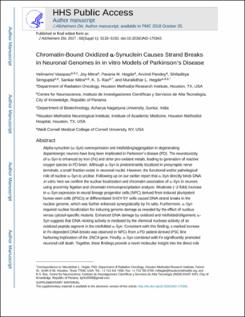| dc.contributor.author | Vasquez, Velmarini | |
| dc.contributor.author | Mitra, Joy | |
| dc.contributor.author | Hegde, Pavana M | |
| dc.contributor.author | Pandey, Arvind | |
| dc.contributor.author | Sengupta, Shiladitya | |
| dc.contributor.author | Mitra, Sankar | |
| dc.contributor.author | Rao, KS Jagannatha | |
| dc.contributor.author | Hegde, Muralidhar L | |
| dc.date.accessioned | 2020-06-25T02:42:09Z | |
| dc.date.available | 2020-06-25T02:42:09Z | |
| dc.date.issued | 2017-01-01 | |
| dc.identifier.other | 10.3233/JAD-170342 | |
| dc.identifier.uri | http://repositorio-indicasat.org.pa/handle/123456789/114 | |
| dc.description | Alpha-synuclein (α-Syn) overexpression and misfolding/aggregation in degenerating dopaminergic neurons have long been implicated in Parkinson’s disease (PD). The neurotoxicity of α-Syn is enhanced by iron (Fe) and other pro-oxidant metals, leading to generation of reactive oxygen species in PD brain. Although α-Syn is predominantly localized in presynaptic nerve terminals, a small fraction exists in neuronal nuclei. However, the functional and/or pathological role of nuclear α-Syn is unclear. Following up on our earlier report that α-Syn directly binds DNA in vitro, here we confirm the nuclear localization and chromatin association of α-Syn in neurons using proximity ligation and chromatin immunoprecipitation analysis. Moderate (~2-fold) increase in α-Syn expression in neural lineage progenitor cells (NPC) derived from induced pluripotent human stem cells (iPSCs) or differentiated SHSY-5Y cells caused DNA strand breaks in the nuclear genome, which was further enhanced synergistically by Fe salts. Furthermore, α-Syn required nuclear localization for inducing genome damage as revealed by the effect of nucleus versus cytosol-specific mutants. Enhanced DNA damage by oxidized and misfolded/oligomeric α-Syn suggests that DNA nicking activity is mediated by the chemical nuclease activity of an oxidized peptide segment in the misfolded α-Syn. Consistent with this finding, a marked increase in Fe-dependent DNA breaks was observed in NPCs from a PD patient-derived iPSC line harboring triplication of the SNCA gene. Finally, α-Syn combined with Fe significantly promoted neuronal cell death. Together, these findings provide a novel molecular insight into the direct role of α-Syn in inducing neuronal genome damage, which could possibly contribute to neurodegeneration in PD. | en_US |
| dc.description.abstract | Alpha-synuclein (α-Syn) overexpression and misfolding/aggregation in degenerating dopaminergic neurons have long been implicated in Parkinson’s disease (PD). The neurotoxicity of α-Syn is enhanced by iron (Fe) and other pro-oxidant metals, leading to generation of reactive oxygen species in PD brain. Although α-Syn is predominantly localized in presynaptic nerve terminals, a small fraction exists in neuronal nuclei. However, the functional and/or pathological role of nuclear α-Syn is unclear. Following up on our earlier report that α-Syn directly binds DNA in vitro, here we confirm the nuclear localization and chromatin association of α-Syn in neurons using proximity ligation and chromatin immunoprecipitation analysis. Moderate (~2-fold) increase in α-Syn expression in neural lineage progenitor cells (NPC) derived from induced pluripotent human stem cells (iPSCs) or differentiated SHSY-5Y cells caused DNA strand breaks in the nuclear genome, which was further enhanced synergistically by Fe salts. Furthermore, α-Syn required nuclear localization for inducing genome damage as revealed by the effect of nucleus versus cytosol-specific mutants. Enhanced DNA damage by oxidized and misfolded/oligomeric α-Syn suggests that DNA nicking activity is mediated by the chemical nuclease activity of an oxidized peptide segment in the misfolded α-Syn. Consistent with this finding, a marked increase in Fe-dependent DNA breaks was observed in NPCs from a PD patient-derived iPSC line harboring triplication of the SNCA gene. Finally, α-Syn combined with Fe significantly promoted neuronal cell death. Together, these findings provide a novel molecular insight into the direct role of α-Syn in inducing neuronal genome damage, which could possibly contribute to neurodegeneration in PD. | en_US |
| dc.language.iso | en | en_US |
| dc.subject | Alpha-synuclein | en_US |
| dc.subject | iPSC-derived neural progenitor cells | en_US |
| dc.subject | iron | en_US |
| dc.subject | neurodegeneration | en_US |
| dc.subject | Parkinson’s disease | en_US |
| dc.title | Chromatin-bound oxidized α-synuclein causes strand breaks in neuronal genomes in in vitro models of Parkinson’s disease | en_US |
| dc.type | Article | en_US |

